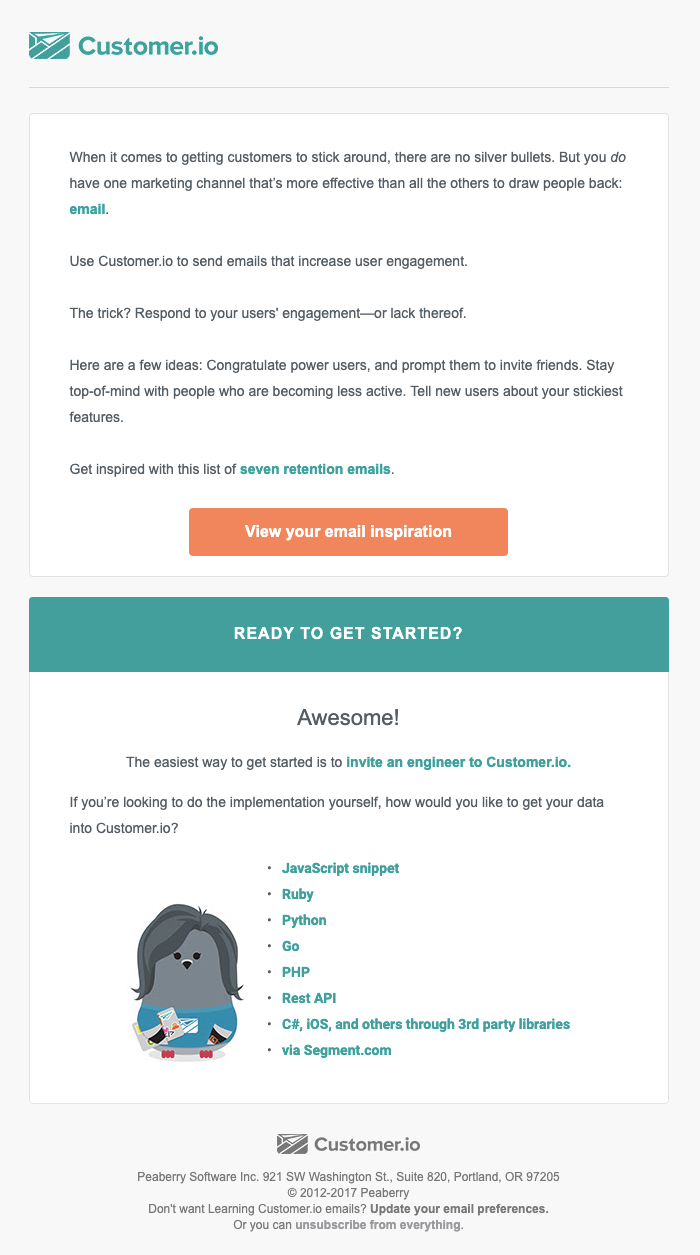How to Decide Which Emails in a Series to Keep
There’s never a shortage of choices to be made in SaaS email marketing.
Which email series do we need? Is the tone of this email okay? What day should we send this? How do we know it’s working?
We can’t tackle every email marketing decision today (sorry), but I do plan on making your life at least a little bit easier. This post is for anyone that has a set of emails that they’re considering updating.
I tend to write about onboarding emails most, but this thought framework can really be applied to any of your SaaS emails.
The goal of this post is to help you sort out which emails you should keep, which you should edit, and which you should trash.
You can use this process for auditing existing email series, or as a check before you finalize a new batch of messages. This thought process is similar to how I conduct onboarding email breakdowns and can be used alongside this post about auditing strategy.
6 Questions to Audit Your SaaS Emails
There are three primary email components you’ll use to audit your emails: subject line, contents, and CTA. The subject line affects your open rates, while the contents are make-or-break for click-throughs. The five questions below are useful for checking both your subject line and email copy.
Does it have a clear objective?
Sometimes I think of emails like arrows. If they aren’t clearly pointing to the next step, they’re failing at their job. When you look at a particular email, can you name one next step that people should do? If the objective isn’t clear, someone may not act.
Also, consider whether or not the email is accurate to what it leads to. A beautiful arrow that says one thing but takes someone to another isn’t good. The button should either take a person to where they need to be to carry out the action or give them directions for how to get there.
Keep the email if there’s a clear next step and the destination makes it easy peasy for someone to take action.
Edit the email if there’s too much going on.
Delete the email if it never had an objective, never will, or doesn’t tell a compelling story.
Is it customer-focused?
Your only chance of success as a company is if you help people succeed. As such, your emails need to be customer first. I’m not telling you to ditch awesome social proof, but try to float customer benefits to the top. Put yourself in the shoes of the user and ask “what’s in it for me?” to check for this. Each email should highlight benefits, solve an issue, connect with their experience, etc.
Keep the email if you address why a person would care.
Edit the email if it’s too technical or focuses too much on you.
Delete the email if there’s no way to make the content benefit the reader or make them feel more secure in their decision, inspired to take action, etc.
Want to see what a customer-focused edit looks like firsthand? Below is an email I received as part of my Customer.io Onboarding Email Breakdown.
Although I like the email overall, I suggest a simple edit to make it more compelling for readers:
“When it comes to getting customers to stick around, there are no silver bullets. But you do have one marketing channel that’s more effective than all the others to draw people back: email.
The trick? Respond to your users' engagement—or lack thereof.
You can increase user engagement by sending targeted emails with Customer.io
Here are a few ideas: Congratulate power users, and prompt them to invite friends. Stay top-of-mind with people who are becoming less active. Tell new users about your stickiest features.
Want to use email to keep customers around? Get inspired with this list of seven retention emails.”
All I did was swap the order of two sentences in the middle. By moving the customer-focused statement first, the reader is pulled into the story through a familiar pain, offered an answer, and then served a solution.
Is it attention-grabbing or memorable?
Don’t get it twisted—I’m not telling you to turn your marketing department into clickbait city. BUT if your subject lines or emails are a snooze fest I’m liable to delete and move on. Your brand doesn’t have to be crazy and funny, but you shouldn’t be stuffy either. Review your copy and ask yourself if it would make someone curious to learn more.
Keep the email if it would make someone pause and read more, or feel like they want to be friends with your brand.
Edit the email if it’s wordy, stale, or full of errors.
Delete the email if it’s inherently misleading or has no value to bring.
Here’s an example of a subject line that doesn’t do justice for the contents. Zendesk sends a customer support email with the subject line “Steph, your Zendesk Trial." My mental response to that subject line is “what about it?” The email is offering help, but the subject line doesn’t reflect that. A question headline would work well here.
Does it make sense?
This seems like an obvious point, but it still needs to be made. When you’re in a company every day, you inevitably understand everything in and out. However, someone outside the org may not have the same understanding. It’s hard to think like a person who knows nothing about your product when you may be the creator, but try to assess an email using ONLY the context in the email. It’s possible that you’re writing and sending emails with assumptions that customers might not have.
Keep the email if your grandma could understand it.
Edit the email if it’s overly technical or jargon-y (even for someone in your audience).
Delete the email if it’s a concept that is too large to explain in one email (break it into separate emails instead).
The example below from Pipefy needs more context. This is the first email from Pipefy, and I would’ve liked to have seen a bit about them. Why do they do what they do? Or, at a high level, what will they help me do? I also think there should be more context about what it means to “create a card” and why it matters at this moment.
Is it unique?
Life (and email marketing) is about balance. Sometimes, some topics are so important they deserve to be covered multiple times. On the other hand, you don’t want to sound like a broken record. If you have multiple emails in the same series that talk about the same feature or use case you have a decision to make.
If you’re talking about the one key feature that could really make or break a user’s experience, go ahead and bring it up a few times. However, if the content of an email isn’t wildly different from another email, you may be able to free up space for more essential topics.
Keep the email if its contents are critical and/or unique within the series.
Edit the email if a different angle would make the content fresh.
Delete the email if it’s redundant and could be swapped out for something more impactful.
Is it working?
The previous questions on the list took an “inside out” perspective, but you also need to take user feedback into consideration. So, take note of the open rate, click through rate, unsubscribe rate, and conversion rate for each email. Consider how the email has performed against itself over time, and against your other emails. Also analyze whether or not the email is accomplishing what you wanted it to.
Keep the email if it has a strong open rate, CTR, unsubscribe rate, and conversion rate.
Edit the email if one metrics, such as the open rate, falls behind your company’s normal.
Delete the email if it flops even after you’ve edited it, or you receive a lot of negative feedback on it.
We’ve covered all these useful questions, and now it’s time for you to apply them to your emails. First, go through your emails one by one and check them for writing tone, spelling, and content. Then, look at the emails in the context of the email series. Do the tones align? Do they cover all the important points you need to hit? It’s equally powerful to analyze emails individually and as a whole.
Have any questions about auditing your SaaS emails? Send me a message here.














I compared 153 SaaS email subject lines to find common themes, best practices, and style choices.